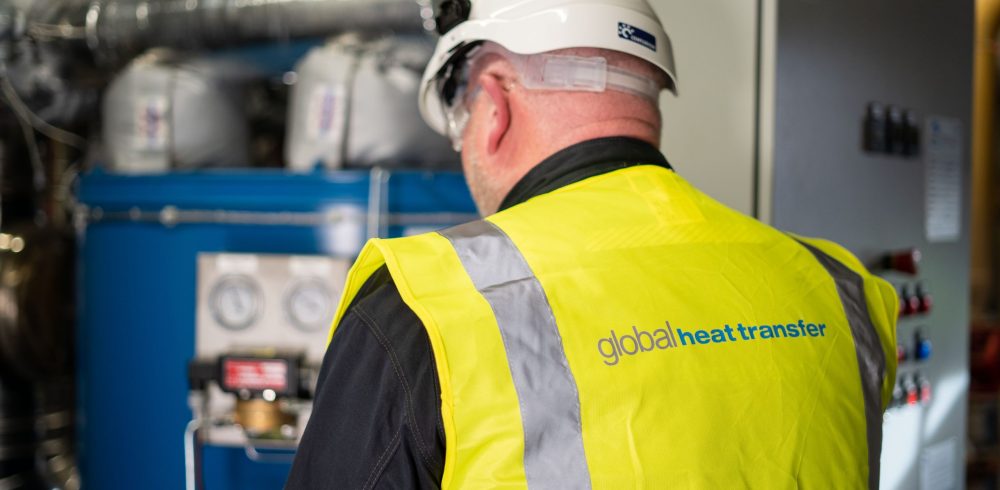Thermal fluid systems are often perceived as low maintenance because of their stability and reliability, operating effectively a closed-loop system with minimal intervention. However, with rising operational costs, changing environmental regulations and increased competition, uptime and process efficiency are more critical factors than ever. That’s why manufacturers should take proactive steps to maintain their heat transfer fluids and HTF system, says Dave Dyer, technical sales engineer at thermal fluid experts Global Heat Transfer.
Thermal fluid systems typically run well for many years with limited intervention. However, all thermal fluids degrade over time, and so a reactive maintenance strategy means that any degradation or build up of contaminants may go unnoticed until it significantly impacts operations, leading to reduced efficiency and/or a drop in quality.
When problems arise or production levels drop, engineers may have to resort to a quick fix to minimise downtime, such as turning up the heat of the system — increasing resource and energy consumption. This, combined with the risk of downtime, means many facilities are moving away from reactive and towards a more proactive approach.
Reactive to proactive
Implementing a proactive thermal fluid maintenance strategy, such as Thermocare®, tailored to the system’s specific needs enables engineers to better understand and maintain their system. Proactive maintenance can help improve uptime, conserve resources and extend the lifetime of fluid and equipment.
By conducting an assessment of existing practices and considering common failures or pain points, manufacturers can identify potential areas for improvement. The maintenance plan should include regular inspections of core components, preventative maintenance tasks, increasing staff knowledge and predictive analytics. By identifying potential issues during these inspections, engineers can intervene promptly.
Proactive maintenance enhances operational efficiency by preventing equipment failures and minimising unplanned downtime, allowing for smoother production processes and increased productivity.
Beyond operational efficiency, proactive maintenance promotes sustainable practices by reducing waste, emissions and energy consumption. Adhering to proactive fluid maintenance procedures can optimise performance, extend equipment lifespan and reduce the regularity of thermal fluid changes, helping to reduce waste and conserve energy.
Furthermore, by extending equipment lifespan and optimising fluid performance, proactive maintenance helps manufacturers reduce long-term maintenance costs and improve overall profitability.
Fluid maintenance
Regular fluid monitoring is a key part of proactive maintenance because once the thermal fluid enters the system, it is no longer visible. Sampling fluid when the system is closed, hot and circulating will help provide an accurate representation of what’s happening inside the system.
Analysis of the fluid sample enables engineers to determine if there are any immediate signs of degradation. Engineers can also track sample data over time to better identify trends in performance and contamination levels to better monitor fluid condition. By monitoring trends, engineers can plan in maintenance, devising a plan for how to intervene, with options such as fluid dilution or filtration available to address changes in fluid condition as needed. Installing a filtration system that can remove solid carbon deposits or other contaminants can help improve the condition of the existing fluid and reduce wear on system components caused by contaminants.
Remote condition monitoring tools, such as Thermocare 24/7 Live Condition Monitoring, can further support thermal fluid management. By continuously tracking fluid condition, engineers can access real-time data from any location. Maintenance engineers can receive alerts as soon as fluid condition changes, so that they can address it quickly before a problem occurs.
Knowledgeable staff
Having a well-trained team of engineers proficient in operating and maintaining equipment is integral to improving maintenance procedures. Increasing team understanding about the heat transfer system and thermal fluid equips engineers with the knowledge and skills necessary to anticipate and address potential issues before they escalate.
Training on key activities, such as thermal fluid sampling, maintenance, safe handling and storage of fluids and system checks ensures that employees are aware of what’s required for compliance and proactive maintenance. Training on safety, PPE and where to access equipment like fire extinguishers and spill kits in case of a leak is also important. Comprehensive training on proactive maintenance not only prevents costly downtime and extends equipment lifespan, it can also help conserve resources, reduce energy consumption and maintain uptime.
Safeguarding your system
When signs of thermal fluid degradation appear, engineers can install complementary components to address any issues. Insulation, for example, can minimise heat loss, decrease energy consumption and improve facility temperature control, extending fluid and system lifespan.
Another possible situation is a build-up of light ends, short chain hydrocarbons that can form as a degradation product of thermal oil, which lower the flash point of the fluid and can be detrimental to health and safety. A light ends removal kit (LERK) installed onto the system effectively captures and removes these volatile compounds, further extending the lifespan of the fluid.
Even with diligent maintenance, after years of service a thermal fluid will eventually degrade to a point at which it must be replaced. At this point, a thermal fluid specialist can help dispose of the fluid as sustainably as possible by arranging repurposing or reprocessing of material for a different application or industry where possible.
By implementing procedures that improve proactive maintenance and system efficiency, manufacturers not only minimise downtime, they can conserve resources, reduce costs and reduce emissions where possible, resulting in a more resilient manufacturing process.
Looking for support with your thermal fluid maintenance programme? Set up a call with our team of thermal fluid experts.
Manufacturing & Engineering Magazine | The Home of Manufacturing Industry News















